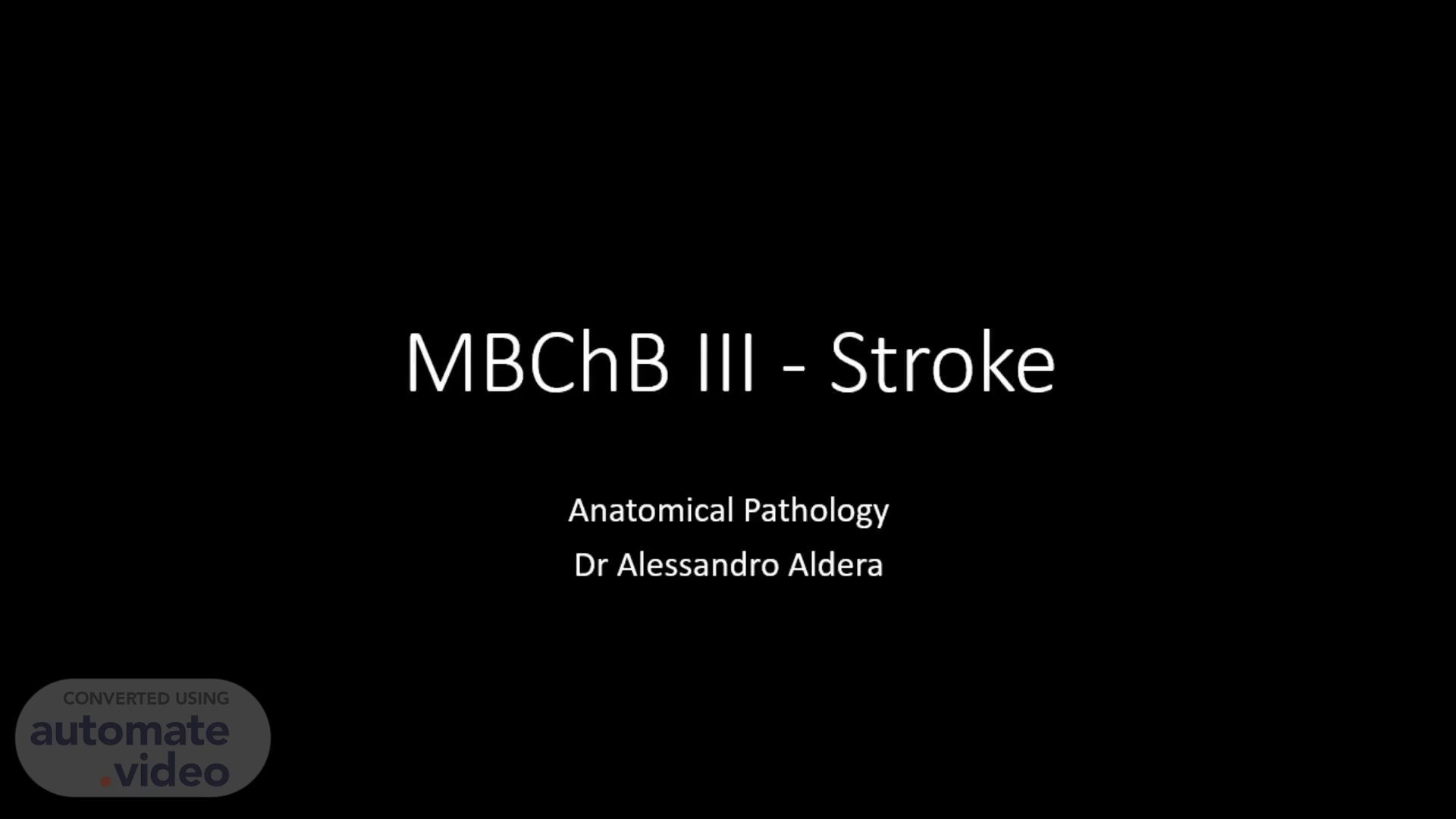Scene 1 (0s)
MBChB III - Stroke. Anatomical Pathology Dr Alessandro Aldera.
Scene 2 (15s)
Learning objectives:. Identify a neuroradiological investigation as a CT scan or MRI and if the latter, be able to determine if it shows fat or fluid signals [T1 or T2 weighting]. Demonstrate the vascular territories of the brain. Identify, describe and give possible causes for: pale infarcts haemorrhagic infarcts laminar necrosis watershed infarcts Definition and classification of stroke..
Scene 3 (54s)
List and describe the cerebral causes of intracerebral haemorrhage. Describe the site, cause and macroscopic appearance of Charcot Bouchard aneurysms. Describe the clinical effect of rupture of Charcot Bouchard aneurysms and the macro appearance. Identify and give causes for subarachnoid haemorrhage..
Scene 4 (1m 19s)
Primer on Neuroradiology.
Scene 5 (1m 25s)
Computed tomography:. Computed tomography (CT): several x-ray beams and electronic x-ray detectors rotate around the patient, these measure the amount of radiation being absorbed throughout the patient’s body CT is particularly good for haemorrhage, trauma or fracture to the skull and for hydrocephalus Uses radiation. Bones = white Soft tissue = shades of grey Air = black.
Scene 6 (2m 12s)
R. L.
Scene 7 (2m 28s)
Neuroscience for Kids - Directions/Planes. https://faculty.washington.edu/chudler/slice.html.
Scene 8 (2m 45s)
Brain Imaging in Hypertensive Hemorrhage: Practice Essentials ....
Scene 9 (3m 4s)
Nobel Prize. Allan MacLeod Cormack South African physicist won the 1979 Nobel Prize in Physiology or Medicine One of UCT’s 5 Nobel laureates Develop the theoretical underpinnings of CT scanning.
Scene 10 (3m 21s)
Magnetic Resonance Imaging:. Radio waves realign hydrogen atoms that exist within the body. As the hydrogen atoms return to their usual alignment, they emit different amounts of energy depending on the type of body tissue they are in. The scanner captures this energy and creates a picture using this information. No radiation. MRI can detect stroke at a very early stage (30min) by mapping the motion of water molecules in the tissue..
Scene 11 (3m 53s)
MRI Basics.
Scene 12 (4m 6s)
Tl = Arnold is bad = Arnold is good Sarah Connor, Your Terminated! = therefore water is dark = therefore water is light Tl = Arnold is Bad = Water is Dark Come with me if you want to live! T2 = Arnold is Good = Water is Light.
Scene 14 (4m 37s)
Glioblastoma | Radiology Reference Article | Radiopaedia.org.
Scene 15 (4m 50s)
Vascular Territories.
Scene 16 (4m 56s)
Territorial Strokes as a Tool to Learn Vascular Territories ....
Scene 17 (5m 25s)
Diagrams showing: the vascular territories supplied by the ....
Scene 18 (6m 8s)
Stroke Territories and Resulting Syndromes and Effects #Stroke ....
Scene 19 (6m 22s)
Brain Ischemia - Vascular territories | Radiology, Vascular, Mri brain.
Scene 20 (6m 44s)
Stroke.
Scene 21 (6m 50s)
Stroke. Definition : a neurological disability (presumed to be cerebro-vascular) lasting longer than 24 hrs. TIA (reversible, <24 hrs) Aetiology : 75% are due to atherosclerosis and thromboembolism 15% spontaneous intracranial haemorrhage (subarachnoid or parenchymal).
Scene 22 (7m 16s)
Risk factors:. Hypertension Diabetes mellitus Heart disease (IHC, CM, CCF, AF) Smoking Age, gender Race Personal or family history of stroke or TIA Brain aneurysms or AVMs.
Scene 23 (7m 44s)
Gross Pathology - Infarction.
Scene 24 (7m 50s)
BP. BP. Pale infarct Haemorrhagic infarct. Laminar necrosis Watershed infarct.
Scene 25 (8m 6s)
Pale infarcts:. End of arterial territory. Dr. Mohammed Alorjani, EBP - ppt video online download.
Scene 26 (8m 36s)
Haemorrhagic infarcts:. Causes: Reperfusion of pale infarct Superior sagittal sinus thrombosis.
Scene 27 (9m 3s)
Laminar necrosis:. Poor perfusion over area of arterial territory Selective vulnerability of cortical neurons Loss of neurons (glia and vessels still viable) with thinning of the cortex Not true infarction.
Scene 28 (9m 30s)
Laminar necrosis. Gray matter has a laminar appearance (III and V highly vulnerable). Slow process so pt must survive hypoxia.
Scene 29 (9m 48s)
Watershed infarcts:. Wedge-shaped areas of infarction that occur in those regions of the brain and spinal cord that lie at the most distal fields of arterial perfusion Zone between ACA and MCA highest risk Global ischaemia due to hypotension leading to cell death.
Scene 30 (10m 18s)
Intracranial haemorrhage.
Scene 31 (10m 23s)
Subarachnoid Haemorrhage - Clinical Features - Management ....
Scene 32 (10m 50s)
Intracerebral haemorrhage:. AKA intraparenchymal Spontaneous (non-traumatic) cases occur in 60s Most are caused by rupture of a small intraparenchymal vessel Causes : Hypertension (basal ganglia, thalamus, pons, cerebellum) Cerebral amyloid angiopathy (CAA) – amyloidogenic peptides deposited in walls of medium and small meningeal and cortical vessels – lobar haemorrhages.
Scene 33 (11m 24s)
Basal ganglia hemorrhage | Radiology Case | Radiopaedia.org.
Scene 35 (12m 1s)
Charcot-Bouchard microaneurysms:. Hypertension affects deep penetrating arteries and arterioles Basal ganglia, hemispheric white matter, brain stem Hyaline arteriolar sclerosis Small (<300 microns) aneurysms can develop (CB) Major complication is rupture.
Scene 36 (12m 28s)
Charcot Bouchard Microaneurysm. Cerebrovascular Disease (Neuro Block) Flashcards | Memorang.
Scene 37 (12m 54s)
Hypertension and Stroke | SpringerLink. https://link.springer.com/chapter/10.1007/978-3-319-25616-0_3.
Scene 38 (13m 5s)
Subarachnoid haemorrhage:. Causes : Rupture of saccular (berry) aneurysm Vascular malformation Trauma Extension of intracerebral haemorrhage Haematological disturbances Tumours.
Scene 39 (13m 20s)
1/3 associated with increased ICP “worst headache ever” 25-50% die with first rupture Recurrent bleeding is common in survivors Multiple in just <1/3 AD PKD association 1.3% per year rate of bleeding (related to size).
Scene 40 (13m 51s)
Subarachnoid hemorrhage | Radiology Case | Radiopaedia.org.
Scene 41 (14m 11s)
Online resources:. http://neuropathology-web.org/.
